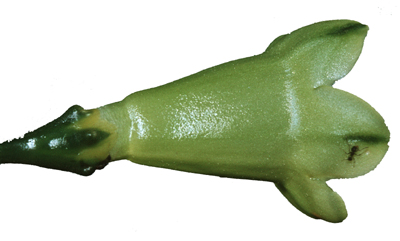SEARCH the
Gentian Research Network
and Rutgers University:
GENTIANS
Classification (newest)
List of genera
List by tribe
Gentian characteristics
Gentianales
RESEARCH
Research projects
People, addresses
Literature, publications
Links
Add info to
this site
TOPICS
Anatomy
Common names
Ecology - Natural history
GEOGRAPHY
Floras
Latin America
North America
TRIBES
Saccifolieae
_____________________
Information in other languages:
_____________________
This page
is maintained
by Dr.
Lena
Struwe
(e-mail),
and hosted by
Rutgers University, USA
updated: 01/19/11
| Chelonanthus (Gentianaceae: Helieae: Chelonanthus) |
 |
|||||||||||||||||
|
Chelonathus alatus: Sasafrás de loma, Tabaco de morrocoy, Tabaquilla Chelonanthus albus: Sarusa, Tabaco de venado, Tabaco picure Chelonanthus angustifolius: Sasafrás de loma Chelonanthus purpurascens: Wakauyek, Wild tobacco. Latin
name and synonyms: Chelonanthus (Griseb.) Gilg
in Engl. & Prantl, Nat.
Pflanzenfam. 4(2): 98 (1895) Etymology: The meaning of the name Chelonanthus can only be hypothesized, since we have no records of Grisebach's thoughts when he described the name. In Greek, chelone (or cheilona) means tortoise and was a name of a Greek goddess (link), and anthos means flower. The North American genus Chelone, the turtlehead plant (Scrophulariaceae), has a zygomorphic corolla with a slightly hooded upper lip that resembles the shell of a tortoise. In Chelonanthus, you also find slightly zygomorphic corollas that are slightly curved and rounded in their upper part (for example, see C. angustifolius drawing). With this explanation, the name Chelonanthus means 'turtle gentian' Species: ca. 7-10 (?). This genus is currently being studied by Kate Lepis and there appears to be several undescribed species in the genus. Distribution: Neotropics, from Mexico to Bolivia, not including the Caribbean Islands (but present on Trinidad). Habitat: Forests, roadsides, savannas, and grasslands in tropical America. Characteristics: Annual or perennial herbs (up to 3.5 m tall), sometimes woody at the base. Leaves sessile or petiolate, variously shaped. Inflorescences terminal, many-flowered, with monochasial branches (flowers one by one on one side of the branch), with scale-like bracts. Flowers 5-merous, often horizontal or nodding, actinomorphic or slightly zygomorphic. Calyx campanulate, divided down to at least ˝ of their length, thick and leathery, persistent in fruit; calyx lobes elliptic with a dorsal glandular ridge. Corolla campanulate to funnelshaped, blue, purple, green, yellowish, or white, with rounded lobes. Stamens subequal to unequal length, filaments sometimes strongly bent close to the anther. Anthers straight or recurved (to 360°), with a sterile apical appendage. Pollen released as tetrads (most species) or polyads (Chelonanthus purpurascens only). Ovary with glandular disk at the base; style long, slender, and persistent in fruit; stigma bilamellate. Capsules elliptic, open in the middle, often nodding.
Evolution and related plants: Chelonanthus belongs to the Symbolanthus clade in the tribe Helieae, and is a paraphyletic genus. In its current circumscription it does not form a natural group. The green and white flowered Chelonanthus species appear to be most closely related to Symbolanthus and Wurdackanthus, but the blue to purple-flowered Chelonanthus purpurascens is placed close to other genera in the same clade. Economic uses: Some species are used for medicinal purposes. Notes: Chelonanthus has sometimes been included in the genus Irlbachia, but this is not supported by new, evolutionary DNA evidence (Struwe et al., 2002). Accepted species (synonyms in parenthesis) and their distribution:
Gilg, E. 1895. Gentianaceae. Pp. 50-180. In: A. Engler & K. Prantl, editors. Die natürlichen Pflanzenfamilien, vol. 4(2). Verlag von Wilhelm Engelmann, Leipzig. Maas, P. J. M. 1985. Nomenclatural notes on neotropical Lisyantheae (Gentianaceae). Proc. Kon. Ned. Akad. Wetensch., Ser. C, 88: 405-412. Maas, P. J. M., S. Nilsson, A. M. C. Hollants, B. J. H. ter Welle, H. Persoon, & E. C. H. van Heusden. 1983. Systematic studies in neotropical Gentianaceae – the Lisianthius complex. Acta Bot. Neerl. 32: 371-374. Machado, I. C. S., I. Sazima, & M. Sazima. 1998. Bat pollination of the terrestrial herb Irlbachia alata (Gentianaceae) in northeastern Brazil. Pl. Syst. Evol. 209: 231-237. Nilsson, S. 1970. Pollen morphological contributions to the taxonomy of Lisianthus L. s. lat. (Gentianaceae). Sv. Bot. Tidskrift 64: 1-43. Pringle, J. S. 1995. Gentianaceae. Pp. 1-131. In: G. Harling & L. Andersson, editors. Flora of Ecuador, vol. 159A. Department of Systematic Botany, Gothenburg University, Göteborg. Struwe, L. & V. A. Albert. 1998a. Lisianthius (Gentianaceae), its probable homonym Lisyanthus, and the priority of Helia over Irlbachia as its substitute. Harvard Pap. Bot. 3: 63-71. Struwe, L., J. W. Kadereit, J. Klackenberg, S. Nilsson, M. Thiv, K. B. von Hagen, & V. A. Albert. 2002. Systematics, character evolution, and biogeography of Gentianaceae, including a new tribal and subtribal classification. Pp. 21-309. In: L. Struwe & V. A. Albert (eds.), Gentianaceae: Systematics and Natural History, Cambridge University Press, Cambridge. Struwe, L., P. J. M. Maas, & V. A. Albert. 1997. Aripuana cullmaniorum, a new genus and species of Gentianaceae from white-sands of southeastern Amazonas, Brazil. Harvard Pap. Bot. 2: 235-253. Struwe, L., P. J. M. Maas, O. Pihlar, & V. A. Albert. 1999. Gentianaceae. Pp. 474-542. In: P. E. Berry, K. Yatskievych, & B. K. Holst, editors. Flora of the Venezuelan Guayana, vol. 5. Missouri Botanical Garden, St. Louis. (images)
© Lena Struwe, 2003 |
||||||||||||||||||

